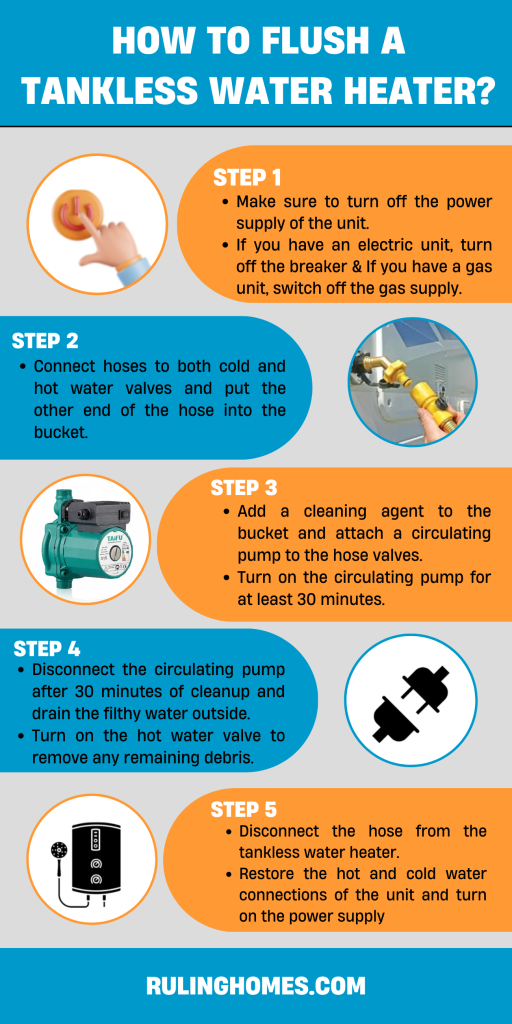Flushing the tankless water heater is a very easy task that can help maintain its efficiency and prolonged lifespan. Here’s a step-by-step guide on how to flush a tankless water heater:
Table of Contents
Step 1
Before you start flushing the tankless water heater, make sure to turn off the power supply of the unit. If you have an electric unit, turn off the breaker in the electric panel. If you have the gas unit, switch off the gas supply.
Step 2
Turn off the cold water supply of the tankless water heater to save water.
Step 3
Connect hoses to both cold and hot water valves and put the other end of the hose into the bucket.
Step 4
Connect a circulating pump to the hose valves present in the bucket, fill the bucket halfway with water, and add a cleaning agent.
Turn on the circulating pump for at least 30 minutes and let the water circulate in the tankless water heater to clean all the magnesium and calcium buildup in the heat exchanger.
Step 5
After 30 minutes of cleanup, disconnect the circulating pump and drain the filthy water accumulated in the bucket outside.
Turn on the hot water valve to clear any remaining debris from the tankless water heater. Repeat the process 3-4 times to completely clean the valves, pipes, and heat exchangers.
Step 6
Disconnect the hose from the tankless water heater. Restore the hot and cold water connections of the unit. And turn on the power supply and let the tankless water heater serve you for another year.
Important factors when flushing the tankless water heater
When flushing a tankless water heater, there are a few important considerations to keep in mind:
Safety first:
Always make sure to turn off the power supply to the unit before starting to flush the tankless water heater. If you have a gas unit, turn off the gas supply as well. Wear protective gear such as gloves and eye protection as hot water and debris can be dangerous.
Water pressure:
Flushing the tankless water heater can cause a sudden drop in water pressure, which may affect other appliances in your home. Make sure to warn anyone using water in your home before you begin the flushing process.
Drainage:
Make sure the drainage area can handle the amount of water being released. You should also ensure that the water is being discharged in a way that won’t cause damage or flooding.
Water quality:
If you have hard water, mineral buildup can accumulate quickly in a tankless water heater. So, it is important to flush the water after a few months to ensure the proper working of the tankless water heater.
Proper procedure:
Always follow the manufacturer’s instructions for flushing your tankless water heater, as specific steps may vary depending on the model and size of tankless water heater.
Following the correct procedure will ensure that the unit is properly cleaned and maintained, which can help to extend its lifespan.
Conclusion
Flushing a tankless water heater is an important maintenance task that can help to maintain its efficiency and prolong its lifespan.
It involves turning off the power supply, connecting a hose to the hot water outlet valve, draining the water heater, reversing the flow, filling the water heater with fresh water, and turning on the power supply.
Safety, water pressure, drainage, water quality, and proper procedure are all important considerations when flushing a tankless water heater. It is recommended to flush the unit at least once a year or more frequently if you have hard water. You can also consult about the frequency from the plumber at the time of installing the tankless water heater unit.
By following the manufacturer’s instructions and taking the necessary precautions, you can ensure that your tankless water heater is properly cleaned and maintained. Interested to know about the limitations of the tankless water heater? Find the downsides of the tankless water heater.

I grew up on a small farm in New Jersey. We had a big family because my parents, my uncles and aunties all were living together on this farm so, you can imagine, it was always over crowded with people. But living in farm was really great because we had to do everything on our own and I learned so many things from my parents and uncles and aunties and that is where I found my passion for fixing things, whether it is renovating or designing, I was always there. Read more

